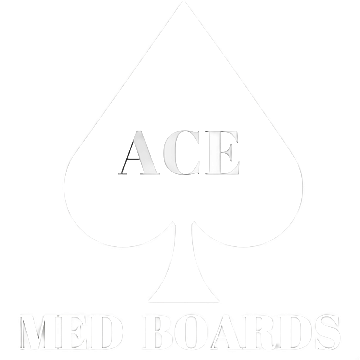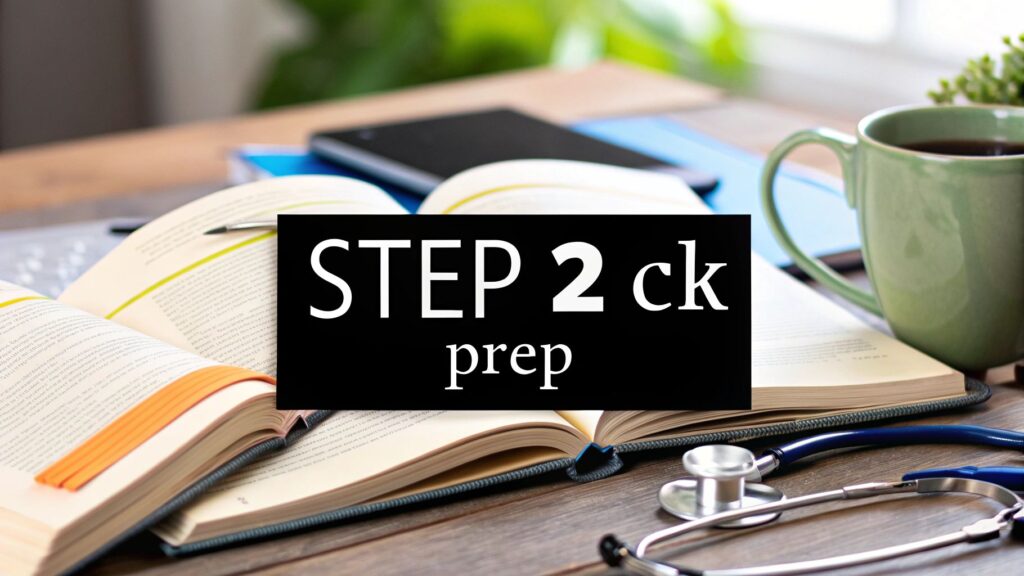Setting Realistic Score Targets Based On Your Specialty Goals
Before we get into the nitty-gritty of how to study for Step 2 CK, let's talk about the destination. It’s incredibly easy to get swept up in the chase for a 270+, but that number might be totally out of sync with your actual career path. This mismatch can lead to a world of unnecessary stress and burnout. The first real move is to figure out what a "good" score means for you and the specialty you're aiming for.
Imagine sitting down with a program director for a competitive surgical subspecialty. They might tell you that while a great score gets your application a first look, they care far more about your surgical rotation grades, research contributions, and letters of recommendation. On the flip side, a director in a field like dermatology might use a high score as a hard-and-fast initial filter. Understanding these differences is everything. Your objective isn't just a number; it's to build a competitive application where Step 2 CK is just one important piece.
Decoding The Numbers: What The Data Shows
Let's ground this conversation in reality. The data tells a compelling story about what it takes to match. For example, 2022 data revealed that hyper-competitive fields like plastic surgery, dermatology, and otolaryngology (ENT) had average Step 2 CK scores around 257 for matched applicants. This is a clear signal that a top-tier score is almost a non-negotiable entry ticket.
However, fantastic specialties like family medicine and psychiatry saw average scores closer to the 241-242 range for their matched applicants. The overall average score for matched U.S. MD seniors was about 250, while unmatched candidates averaged around 242. This 8-point gap highlights a critical truth: scoring above the mean for your target specialty significantly improves your match odds.
To help you visualize where you might need to land, take a look at the table below. It breaks down the numbers for several specialties, giving you a baseline to start from.
| Specialty | Average Score | Competitive Score Range | Match Difficulty |
|---|---|---|---|
| Dermatology | 257 | 250-265+ | Very High |
| Plastic Surgery | 257 | 250-265+ | Very High |
| Otolaryngology (ENT) | 257 | 248-260+ | Very High |
| Orthopedic Surgery | 256 | 245-258+ | High |
| Emergency Medicine | 248 | 240-255+ | Moderate-High |
| Internal Medicine | 248 | 240-255+ | Moderate |
| Psychiatry | 242 | 235-250+ | Moderate |
| Family Medicine | 241 | 230-245+ | Low-Moderate |
This table gives you a solid reference point, showing the clear score stratification between specialties. A score that is highly competitive for Family Medicine might be on the lower end for a specialty like Orthopedic Surgery. Use this data not as a rigid rule, but as a guide to set a realistic and informed goal.
Beyond The Averages: Building Your Target Score
While national averages are a great starting point, they don't capture the full picture. Your personal target score should be a thoughtful mix of this data and your unique application profile.
Here’s how to put it all together:
- Specialty Competitiveness: Use the data as your baseline. If you’re gunning for ENT, a 245 might feel risky. But for family medicine, that same score could make you a very strong candidate.
- Program Tier: Are you aiming for a top-tier academic institution in a major city, or a community-based program? Even within less competitive specialties, top programs often expect higher scores.
- Geographic Location: The competition isn't uniform across the country. Programs in popular coastal cities often see a higher volume of applicants, which can drive up score expectations compared to programs in more rural areas.
- Your Overall Application: Take an honest look at your record. Do you have any red flags, like a failed rotation or a lower-than-desired Step 1 score? A higher Step 2 CK score can be a powerful way to compensate. Conversely, if you have an amazing research portfolio and glowing letters, you might have a little more breathing room on your score.
The objective is to set a score target that is both ambitious and achievable. It should motivate you to prepare with focus, but not set you up for failure. Remember, your first attempt at the exam carries the most weight. Program directors see repeat attempts, so your preparation should be aimed at getting it right the first time. Focus on building a strong, realistic plan that aligns with your specific residency goals, and you'll be well on your way.
Choosing Study Resources That Actually Move The Needle
The world of medical education offers a dizzying array of study aids, making it easy to spend more time collecting resources than actually using them. Many students fall into the "resource overload" trap, subscribing to every well-reviewed platform only to end up with a chaotic and ineffective study plan. The secret to successfully learning how to study for Step 2 CK isn't about owning the most resources; it's about choosing the right ones and mastering them.
After talking with countless high-scoring students, a clear pattern emerges. They don't juggle a dozen different tools. Instead, they master a core set of high-yield resources. Think of it like a master chef: they don't need every gadget ever made. They rely on a high-quality chef's knife, a solid pan, and a dependable oven. Your study materials are your kitchen tools—pick a few great ones and learn to use them with precision.
The Holy Trinity: QBank, Content Review, and Active Recall
The most effective study plans are built on three pillars. This isn't just a theory; it's a proven strategy that directly addresses the demands of the Step 2 CK exam.
The Primary Question Bank (The "Why"): Your main QBank, which for most people is UWorld, is the single most important tool in your arsenal. It’s where you apply knowledge, pinpoint weak spots, and get fluent in the test's unique language. Top students complete it at least once, with many doing a second pass on their incorrect questions. The key is to treat every single explanation as a mini-lecture. Don’t just check if you were right or wrong; dig into the "why" behind every answer choice.
A Targeted Content Review Source (The "What"): You can't answer questions without a solid knowledge base. This is where a video series or a focused textbook shines. Visual learners often do well with platforms like Boards and Beyond or Online MedEd, which connect pathophysiology to clinical presentations with diagrams and lectures. If you're a text-based learner, a book like Step-Up to USMLE Step 2 CK offers a great framework, especially with its helpful tables and flowcharts. It can become a central place to annotate notes from your QBank, creating a personalized, high-yield study guide.
An Active Recall Tool (The "How"): This is what cements information for the long term, and Anki is the undisputed champion. The best approach isn't downloading a massive, pre-made deck. Instead, create your own flashcards based on concepts you miss in your QBank or find confusing. This act of creation is a powerful form of learning itself. Aiming for 30-50 new, self-made cards per day keeps the task manageable and directly targets your personal weaknesses.
To help you choose the best resources for your study style and budget, here is a comparison of the most popular options.
Essential Step 2 CK Study Resources Comparison
Detailed comparison of popular study materials including cost, strengths, and optimal usage timing
| Resource | Cost | Best Used For | Time Investment | User Rating |
|---|---|---|---|---|
| UWorld | ~$439-$739 | Primary QBank, active learning, simulating exam style | 2-3 months (full pass) | ★★★★★ |
| Amboss | ~$35/month – $239/year | Secondary QBank, clinical reference, content library | Variable (use as needed) | ★★★★☆ |
| Boards and Beyond | ~$199-$399 | Content review, building foundational knowledge | 4-6 weeks (focused) | ★★★★☆ |
| Online MedEd | ~$365/year (premium) | Clinical framework, structured video content | 3-5 weeks (focused) | ★★★☆☆ |
| Anki | Free (desktop), ~$25 (iOS) | Active recall, long-term retention of missed concepts | Daily (30-60 mins) | ★★★★★ |
| NBME Self-Assessments | ~$60 per exam | Gauging readiness, predicting score, identifying weaknesses | 4-5 hours per exam | ★★★★★ |
This table shows that your core, non-negotiable investments are UWorld and the NBME exams. Other resources like Amboss or video platforms are excellent supplements but should be chosen based on your specific learning needs and whether you have extra time after mastering the essentials.
Here’s a look at how to visualize a balanced study approach, prioritizing key tasks and maintaining structure.

This visual highlights the need for a structured schedule where your core resources have a dedicated slot each day.
Making Smart Investments: Where to Spend and Where to Save
Preparing for Step 2 CK can get expensive, but you don't need to purchase everything. Your main financial investment should be your QBank (UWorld) and several NBME self-assessments. These are non-negotiable because they provide the most accurate simulation of the real exam experience and question style.
So, where can you save money? Be cautious about expensive, all-in-one courses unless you've identified a major gap in your knowledge or need external accountability. Many students achieve fantastic scores through disciplined self-study using the core resources mentioned above. Don't feel pressured to buy a secondary QBank like Amboss unless you've completely finished UWorld and still have plenty of time. Often, a more thorough review of UWorld yields better results than a superficial pass through a second QBank. The goal is depth, not breadth. Choose wisely, commit fully, and you'll build the foundation you need for success.
Building a Study Schedule That Survives Real Life

Let's get one thing straight: the perfect, color-coded, 12-hour-a-day study schedule is mostly a myth for medical students. The real work of learning how to study for Step 2 CK is about fitting your prep into a life filled with clinical rotations, personal responsibilities, and the very real need for sleep. A schedule that actually works isn't one that looks amazing on paper; it's one that can bend when life gets messy. The goal is a realistic, flexible plan that adapts to your reality.
The first step is figuring out your timeline. Are you able to carve out a hyper-focused 4-6 week dedicated period, or does your life demand a slower, more integrated 4-6 month plan? A dedicated period, usually meaning 8-10 hours of focused study each day, is great if you can clear your schedule after finishing your core rotations. But if you're trying to study while on a demanding surgery or internal medicine rotation, a longer-term approach is far more practical. This might look like committing to one QBank block and a 30-minute Anki review every day, no exceptions. Small, consistent efforts build incredible momentum.
Structuring Your Weeks for Maximum Impact
A solid schedule works on two levels: the big picture and the small details. The big picture is your overall timeline—knowing which weeks are for content review and which are for pounding out full-length practice tests. The small details are how you structure each day and week. A common mistake is trying to be a study machine every single day. A much better approach is to build in planned "catch-up" time and at least one lighter day per week.
This strategy is key for preventing burnout and managing the guilt that hits when you inevitably fall behind. If you miss a study block because a patient case ran late or you were just too wiped out, your schedule should have a built-in slot to absorb that work later without wrecking your entire week. For more ideas on this, our guide on med student time management tips can be a huge help.
Here’s an example of what a balanced week could look like during a dedicated period:
| Day | Morning (High Energy) | Afternoon (Lower Energy) | Evening |
|---|---|---|---|
| Monday | 2 UWorld Blocks (80 Qs) + Review | Content Review (Weak Area) | Anki Review & Relax |
| Tuesday | 2 UWorld Blocks (80 Qs) + Review | Make Anki Cards | Light Exercise |
| Wednesday | 1 UWorld Block + Review | Review Incorrects from Week | Social Time / Hobby |
| Thursday | 2 UWorld Blocks (80 Qs) + Review | Content Review (Weak Area) | Anki Review & Relax |
| Friday | 2 UWorld Blocks (80 Qs) + Review | Make Anki Cards | Plan Weekend |
| Saturday | NBME Practice Exam | Review Exam (2-3 hours) | OFF – No Studying |
| Sunday | Catch-up & Plan Next Week | Light Review (e.g., flashcards) | Meal Prep & Relax |
The Unspoken Curriculum: Sleep, Social Life, and Self-Compassion
Your study schedule is about more than just QBank blocks and video lectures. It’s a whole ecosystem that needs balance. Beyond just blocking out study time, you have to actively integrate expert-backed strategies for deep and restorative sleep. This is absolutely critical for cognitive function and memory consolidation, allowing your brain to actually process what you’ve learned. You simply can't perform at your best on four hours of sleep.
The data backs this up. During the 2023-2024 testing period, a solid 98% of first-time takers from U.S. MD programs passed Step 2 CK. However, for those repeating the exam, that success rate plummeted to 74%. This sharp drop highlights how much success depends on effective initial preparation, which includes managing burnout and keeping a sustainable pace. A realistic, well-planned schedule is your best defense against becoming a repeat-taker statistic. You can explore more USMLE performance data to see these trends for yourself.
Finally, talk to your support system. Let your family and friends know what your schedule looks like and when you'll be less available. Managing their expectations can reduce friction and free up your mental energy. Most importantly, be kind to yourself. Some days you'll feel on top of the world; others will be a grind. A schedule that actually works is one that accepts this from the very beginning.
Mastering Question Banks Beyond Just Getting Answers Right
Just running through a question bank (QBank) like UWorld is the baseline, not the secret to a top-tier score. It's easy to fall into the trap of treating it like a game: you get a question right, feel that quick jolt of satisfaction, and immediately click "next." This is precisely how students hit a performance wall. The real growth happens when you turn every single question—especially the ones you get wrong—into a serious learning moment. This is where the highest performers distinguish themselves. They don't just do questions; they break them down completely.
The true power of a QBank isn't the percentage you see after finishing a block. It's in the methodical review process that comes after. When you get a question wrong, your task isn't to simply memorize the correct answer. You need to figure out exactly where your thought process went off track. Did you misunderstand the lab values? Did you overlook a critical detail in the patient's history? Or was it a straightforward knowledge gap about the underlying pathophysiology? Asking these questions for every incorrect item is a fundamental part of effectively preparing for Step 2 CK.
From Simple Review to Advanced Analysis
Let's elevate your review from a quick glance to a more advanced analysis. This means actively searching for patterns in your mistakes. For instance, after a week of questions, you might realize you consistently miss items about electrolyte imbalances in patients taking diuretics. That's not five separate mistakes; it's a single, glaring weakness you can now attack with targeted study. This approach is much more effective than just re-reading the entire renal physiology chapter.
A simple spreadsheet is a great tool for tracking your errors. Set up columns for the question's topic, the specific reason you missed it (e.g., knowledge gap, misread the stem, overthinking), and what you plan to do about it.
| Topic | Reason for Error | Actionable Step |
|---|---|---|
| Acute Pancreatitis Mgt | Misread question; patient had contraindication to ERCP | Slow down. Re-read the last sentence of the stem before choosing. |
| Differentiating Anemias | Confused iron studies for ACD vs. iron deficiency | Review Boards & Beyond video on Anemias. Create 3-4 Anki cards on key differentiators. |
| Sepsis Criteria | Didn't know all qSOFA components | Memorize qSOFA criteria. Do 5 Amboss questions on Sepsis identification. |
This method forces you to actively engage with your mistakes instead of just passively reading the explanation and moving on. It builds durable clinical reasoning skills because you’re not just learning facts; you’re learning how to apply them under pressure and spot your own cognitive biases.
The Psychology of Question Banks
It's also essential to manage the mental side of working through QBanks. Hitting a series of low-scoring blocks can be incredibly discouraging and might make you want to avoid questions entirely. It's important to remember that your QBank percentage is a learning tool, not a performance metric. Its job is to shine a light on your weak spots so you can strengthen them before test day. Your scores will fluctuate, and that's completely normal. One day you might crush a block on your best subject, and the next day you might struggle with your worst.
Keep your confidence up by focusing on the process, not the daily score. Congratulate yourself for identifying a weakness, because now you have an opportunity to turn it into a strength. A great strategy is to mix up your question blocks. Instead of grinding through only your weak areas—which can be exhausting—alternate them with blocks on subjects you feel more comfortable with. This approach helps maintain your momentum and reinforces what you already know, making sure you don't drop easy points on topics you've already mastered. By treating your QBank as a diagnostic and educational tool, you change the goal from "getting a high score" to "building a deep understanding"—which is what truly drives an excellent Step 2 CK performance.
Study Techniques That Build Clinical Reasoning Skills

Step 2 CK is fundamentally a test of how you think, not just what you know. If your study plan is just flipping flashcards and passively watching videos, you're missing the point. The exam wants to see if you can connect the dots from a patient's story to the underlying disease and its management. It’s time to stop just recognizing facts and start applying them like a real clinician. This requires a shift from passive review to active learning that actually builds lasting mental frameworks.
One of the best ways to do this is to rethink how you take notes. Instead of creating endless documents by copying and pasting text from your QBank, try making concept-based summary sheets. For a big topic like "acute coronary syndrome," dedicate a single page to outlining the entire clinical picture: pathophysiology, risk factors, classic presentation, diagnostic workup (ECG changes, troponins), and the management algorithms for STEMI vs. NSTEMI. Forcing yourself to pull this information from different sources and synthesize it into one story actively builds the mental model you'll need on test day.
Integrating Knowledge Across Specialties
The USMLE doesn't respect rotation boundaries. It will gladly throw you a question that combines pediatric cardiology with an adult genetic syndrome. This is why studying in silos is one of the biggest mistakes you can make. A great way to break down these walls is to actively make connections as you review. For example, when you encounter a beta-blocker while studying cardiology, take an extra five minutes to ask yourself:
- Pulmonology: What's the major contraindication here? (Asthma/COPD)
- Endocrinology: How might this affect a patient with diabetes? (It can mask hypoglycemia.)
- Psychiatry: Are there any mood-related side effects I need to watch for? (Depression, fatigue.)
This habit of "cross-specialty thinking" directly mirrors the structure of the exam and creates a much stronger, interconnected web of knowledge. It turns learning from a simple checklist into a rich, three-dimensional understanding of medicine. This is just one of many powerful study techniques for med students that prioritize deep comprehension over surface-level memorization.
Leveraging Clinical Experience and Strategic Self-Testing
Your time on the wards is an incredibly high-yield study resource. The next time you see a patient with cellulitis, don't just move on. That evening, spend 15 minutes on a quick review: what were the most likely organisms? Why was that specific antibiotic chosen over others? What are the key criteria for hospital admission? Connecting what you see in real life to your study material makes the information stick in a way no textbook can.
This active mindset should carry over to your self-testing. Instead of just re-reading your notes, constantly challenge yourself. Before revealing the answer to a practice question, force yourself to commit to an answer and, more importantly, a reason. Cover up the management section on your summary sheet and try to recreate it from memory. This process of active recall is a much better indicator of exam success than the "percent complete" on a reading assignment.
It's also essential for setting realistic score goals. Mean Step 2 CK scores vary quite a bit by specialty. Fields like plastic surgery and dermatology often see medians over 250, while family medicine and psychiatry are closer to 230. The average score for all test-takers typically lands around 245-247. Knowing these numbers helps you adjust your study intensity to match your career goals. A score of 245 or higher puts you around the 75th percentile, making you a strong candidate for almost any residency. You can explore more detailed score data by specialty to align your prep with your ambitions. Ultimately, building strong clinical reasoning is your best strategy for achieving a competitive score.
Test Day Performance Strategies That Actually Matter
After months of preparing for Step 2 CK, it all comes down to a single, 9-hour test day. Knowing the material is one thing, but performing under that kind of pressure is a different beast entirely. Top scorers don't just win with knowledge; they win with a smart game plan and the mental endurance to execute it from the first question to the last.
Think about that moment in block six when your focus evaporates, or the wave of panic after a brutal set of questions that makes you second-guess everything. These moments are predictable, which means you can prepare for them. The trick is to approach test day not as one long sprint but as a series of controlled efforts with planned recovery in between.
Mastering Your Time and Nerves
Time management on Step 2 CK is less about raw speed and more about preventing panic. Your goal should be to finish each block with a few minutes left over to review any questions you marked. A simple way to stay on track is to check the clock after every 10 questions. If you’re at question 20 with 30 minutes left on the clock, you’re doing great. If you're a bit behind, you know to pick up the pace slightly on the next few questions, avoiding that heart-stopping moment of seeing five minutes left with 10 questions to go.
You're guaranteed to hit questions that completely stump you. The worst response is to let them eat up precious minutes and tank your confidence. Instead, make your best-educated guess, mark it for review, and move on. Your brain often keeps working on it in the background, and you might have an "aha!" moment later. Bouncing back from a tough block is a critical skill. Remind yourself that each block is a fresh start. One hard section doesn't mean you're failing—it could easily be the experimental one. For more great advice, these medical exam study tips can help you build the right mindset for exam day.
Optimizing Your Breaks and Energy
Your break time is just as important as your testing time. Don't waste it by scrolling through your phone or trying to cram a few last-minute facts. The real purpose of breaks is to disconnect and recharge your brain.
Here’s a practical way to use your breaks:
- Go to the restroom every time, even if you don't feel the need.
- Hydrate and have small snacks. A handful of nuts or a protein bar will give you sustained energy without the sugar crash. Avoid anything heavy.
- Stretch and walk around. Move your body to get the blood flowing and give your eyes a break from staring at the screen.
- Never, ever look up answers. This is the single fastest way to destroy your confidence for the rest of the day. What's done is done.
Mental fatigue is your biggest enemy in the later blocks. When you feel your concentration slipping, take 30 seconds to close your eyes, breathe deeply, and consciously reset. This tiny pause can be the difference between making a silly mistake and correctly answering a question you actually know. Trust your gut on your first pass, but use your analytical skills when going back to marked questions. More often than not, that initial instinct is built on thousands of hours of pattern recognition. You've been building that skill all year—now is the time to trust it.
Your Practical Roadmap To Step 2 CK Success
Success on Step 2 CK isn't about a single flash of genius; it's the result of consistent preparation and a smart, actionable strategy. This is where we pull all the pieces together into a practical plan you can start today, no matter where you are in your prep. Whether you have six months or just six weeks, the core ideas of focused effort and strategic adjustments will guide you. This isn't about being perfect. It's about making steady progress.
Think of your preparation in distinct phases, each with a clear purpose. The beginning is for building a solid knowledge base. The middle is for finding and fixing your weak spots. The final weeks are all about hitting your peak performance right on exam day.
Tying It All Together: From Planning To Exam Day
Let's break down this journey into manageable stages. This roadmap gives you clear goals and milestones, helping you stay on course from your very first practice question to your final review session.
The Early Phase (Your First 2-4 Months or Initial 2 Weeks of Dedicated)
This is your foundation-building period. The main goal here is to get through your core resources and establish a broad understanding of the material.
What to do:
- Complete a first pass of your main question bank, like UWorld. At this stage, concentrate on learning from the detailed explanations, not obsessing over your percentage correct.
- Take a baseline NBME exam or look at your early QBank performance to identify your top 5-6 weakest subjects.
- Carve out specific time to review these weak areas using a video platform or review book. This targeted approach is much more effective than re-reading everything.
- Start a daily Anki habit. Make your own cards for concepts you get wrong or find particularly tricky. This active recall will pay off massively down the line.
The Middle Phase (The Grind)
Now, the focus shifts from just acquiring knowledge to sharpening your clinical reasoning and recognizing illness patterns. This is where you turn information into points on the exam.
What to do:
- Start taking full-length NBME self-assessments every 1-2 weeks. This helps build stamina and gets you used to the rhythm and pressure of the actual test.
- Analyze your performance in great detail. Are you consistently missing questions on nephrology? Do you struggle with "next best step" questions? This data is your guide to adjusting your study plan.
- If you've finished your primary QBank, start a second pass of your incorrect and marked questions. This is often more valuable than jumping into a brand-new QBank because it directly targets your known weaknesses.
Staying The Course When Things Get Tough
Let's be real: life will happen. You'll have days where motivation is low or something unexpected throws your schedule into chaos. The key is to have a plan for these moments. If you feel stuck or see your practice scores plateau for more than two weeks, that’s your cue to switch things up. Maybe it's time to trade passive video watching for more active question-based learning, or maybe you just need a full day off to prevent burnout.
Remember that thousands of students successfully pass this exam every single year. They aren't superhuman; they are just incredibly consistent. They show up, put in the work, and give themselves a break when they have an off day. By following a structured yet flexible plan, you're setting yourself up to join them and move one step closer to your residency goals.
Feeling overwhelmed by the sheer volume of material or struggling to create a schedule that fits your life? You're not alone. Sometimes, a personalized touch can make all the difference. The expert tutors at Ace Med Boards specialize in creating customized study plans that align with your unique learning style and schedule. Schedule a free consultation to explore how a one-on-one approach can help you conquer Step 2 CK with confidence.

